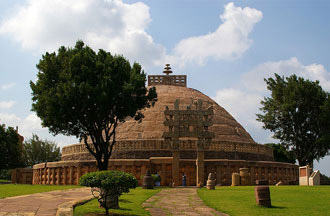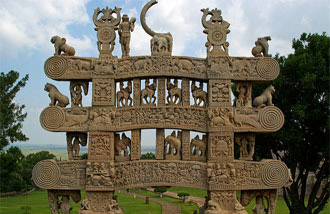Sanchi is a small village in India, located 46 km north east of Bhopal, and 10 km from Besnagar and Vidisha in the central part of the state of Madhya Pradesh. It is unique, not only for having the most perfect and well preserved stupas, but also for offering the visitor a chance to see, in one location, the genesis, flowering, and decay of Buddhist art and architecture during a period of about 1500 years -- almost covering the entire range of Indian Buddhism.

Sanchi is known for its Stupas, monasteries, temples and pillars dating from the 3rd century B.C. to the 12th century A.D. The most famous of these monuments, the Sanchi Stupa 1, was originally built by the Mauryan Emperor Ashoka, the then governor of Ujjayini, whose wife Devi was the daughter of a merchant from adjacent Vidisha. Their son Mahindra and daughter Sanghamitra were born in Ujjayini and sent to Sri Lanka, where they converted the King, the Queen and their people to Buddhism.
History
The 'Great Stupa' at Sanchi was originally commissioned by the emperor Ashoka the Great in the third century BCE. Its nucleus was a simple hemispherical brick structure built over the relics of the Buddha. It was crowned by the chhatra, a parasol-like structure symbolising high rank, which was intended to honour and shelter the relics (Dehejia 1997).
The Emperor Ashoka saw Sanchi as an ideal place to give shape to his newly aroused zeal for Buddhism. It has always been a quiet, meditative place that was, meanwhile, located near the very prosperous city of Vidisha. The success of the Buddhist settlement was due in great measure to the piety of the rich, mercantile community of the nearby city.
The Great Stupa of Sanchi underwent a complete reconstruction after wanton damage inflicted upon it in the middle of the second century BCE. The reconstruction consisted of a stone casing, a terrace with a double flight of steps, balustrades, a paved processional path and an umbrella and railing -- all built of sandstone. Four elaborately carved gateways were added in the first century BCE.
The last addition took place during the rule of the Guptas, sometime before 450 AD. By now effigies of the Buddha were permitted and four stone Buddhas were placed against the walls of the stupa facing the gates. Their haloes are elaborately carved.
What to see
The Great Stupa 1
The present stupa encases an earlier one of about half its present dimensions. The earlier one, built of large burnt bricks and mud, has been attributed to the Emperor Ashoka, the main reasons being that the level of its floor is the same, and that the bricks used in it resemble those in other Ashokan structures.
A Chunar sandstone pillar fragment, shining with the proverbial Mauryan polish, lies near Stupa 1 and carries the famous edict of Ashoka warning against schism in the Buddhist community. Stupa 1 was found empty, while relics of the two disciples of Buddha enshrined in the adjacent Stupa 3 were carried away to England. The nearby modern temple has a reliquary containing the remains of a Buddhist teacher from another Stupa outside Sanchi.
Gateways
The four gateways, or toranas, are the finest works of art at Sanchi and are among the finest examples of Buddhist art in India. The gateways were erected c. 35 BCE. The scenes carved into the pillars and their triple architraves are of episodes in the various lives of the Buddha.

The Eastern Gateway depicts the young prince, Gautama leaving his father's palace on his journey towards enlightenment and the dream his mother had before his birth.
The Western Gateway depicts the seven incarnations of the Buddha. Crowned by a wheel-of-law, the Northern Gateway depicts the miracles associated with the Buddha as told in the jatakas. The Southern Gateway reveals the birth of Gautama in a series of dramatically rich carvings.
Balustrades
The balustrades of the ground-level fence consist of a series of octagonal uprights with lenticular crossbars mortised into them and crowned by enormous copings rounded at the top. The outer faces of the uprights on the berm and stairway are carved with a variety of motifs, mostly flowers. The ground uprights, however, are austerely plain. The reproduction of the technique of wood construction in these balustrades shows that they follow the custom of wooden fences and are probably an innovation here.

Stupa No. 2
The stupa stands at the very edge of the hill and its most striking feature is the stone balustrade that rings it.
Stupa No. 3
Situated close to the great stupa. The hemispherical dome is crowned, as a mark of its special religious significance, with an umbrella of polished stone. The relics of Sariputta and Mahamogallena, two of the Buddha's earliest disciples, were found in its inmost chamber.
The Ashoka Pillar
Lying close to the Southern gateway of the Great Stupa, the Ashoka Pillar is one of the finest examples of the Ashokan pillar and is known for its aesthetic proportions and exquisite structural balance.
The Buddhist Vihara
The sacred relics of the Satdhara Stupa, a few km away from Sanchi, have been enshrined in a glass casket on a platform in the inner sanctum of his modern monastery.
The Great Bowl
Carved out of one block of stone, this mammoth bowl contained the food that was distributed among the monks of Sanchi.
The Gupta Temple
In ruins now, this 5th century AD temple is one of the earliest known examples of temple architecture in India.
The Museum
The Archaeological Survey of India maintains a site museum at Sanchi. Noteworthy antiquities on display include the lion capital of the Ashokan pillar and metal objects used by the monks, discovered during excavations at Sanchi.



